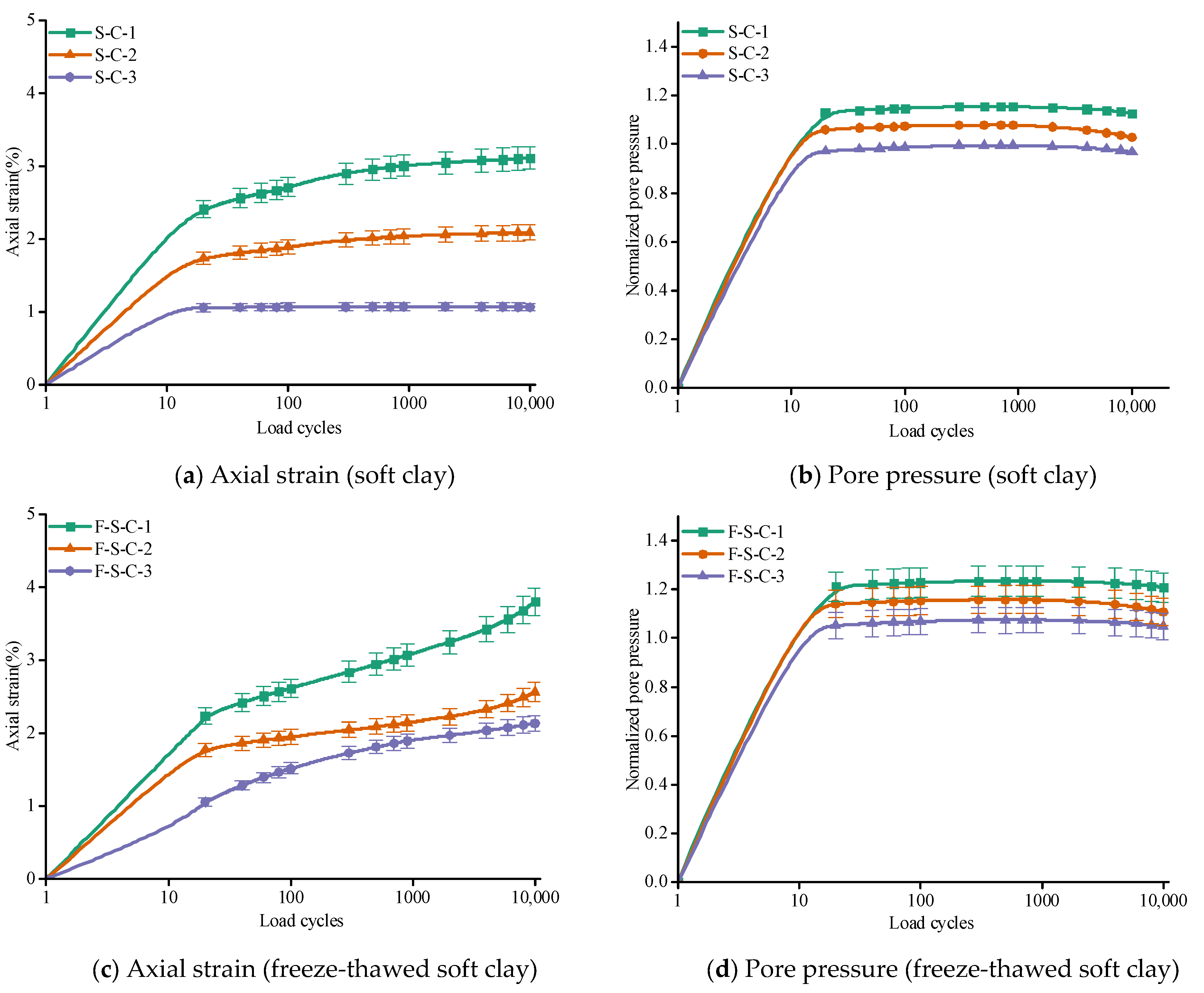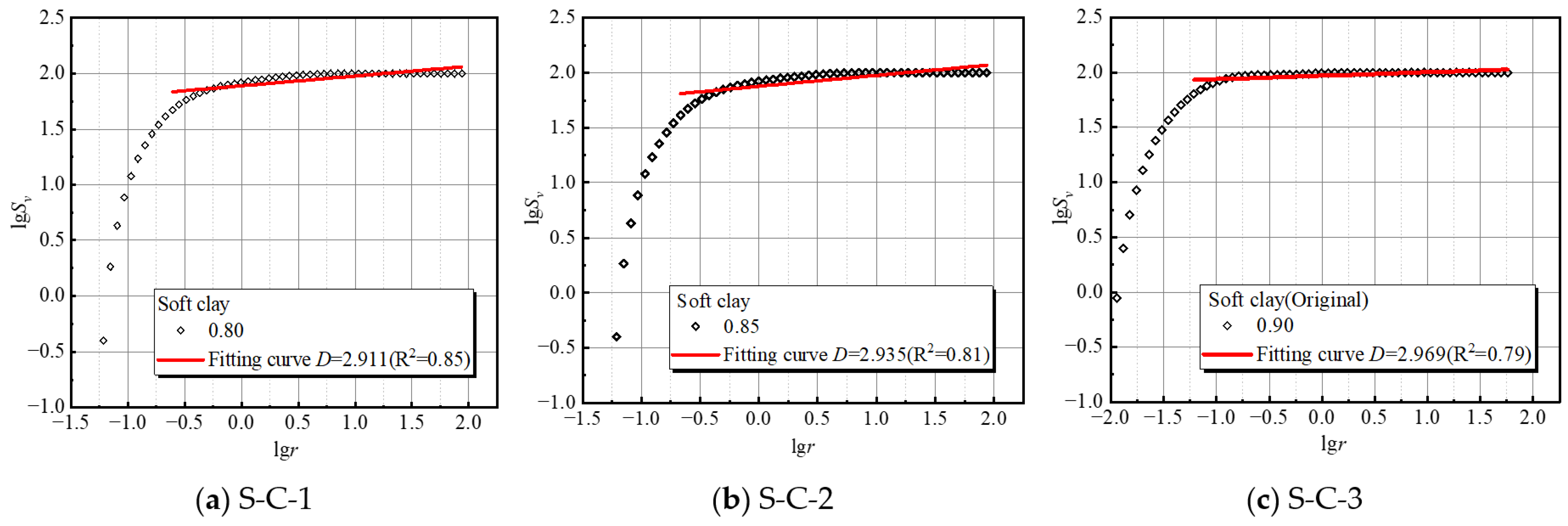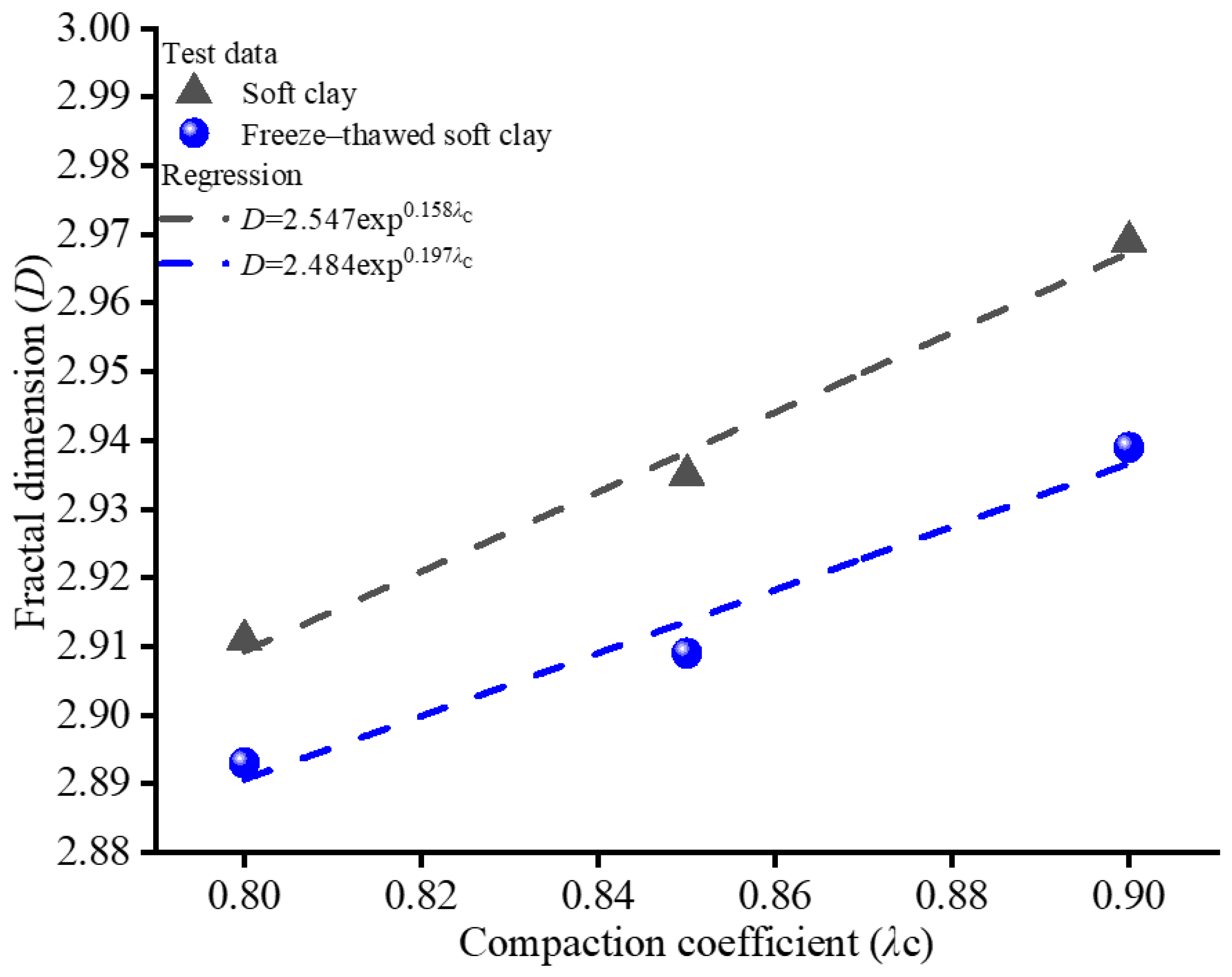Experimental and Microscopic Analysis for Impact of Compaction Coefficient on Plastic Strain Characteristic of Soft Clay in Seasonally Frozen Soil Regions
Abstract
1. Introduction
2. Materials and Methods
2.1. Materials
2.2. Experiments
2.3. Analysis Method of NMR Test
2.3.1. Calculation Method of PSD
2.3.2. Calculation Method of Fractal Dimension Based on Fractal Theory
3. Results
3.1. Triaxial Loading Test
3.2. Pore Size Distribution of Samples
3.3. Fractal Dimension for the Microstructure of Samples
4. Discussion
- (a)
- In this study, repeated loading triaxial tests showed a clear initial compression effect of internal pores, leading to rapid axial strain accumulation during the initial loading phase. As cyclic loading continued, the strain accumulation rate significantly reduced after approximately 20 cycles, indicating stabilization. This pattern suggests initial pore compression and rapid pore water pressure build-up followed by partial dissipation, leading to decreased deformation rates as soil density increases.Following one freeze–thaw cycle at −10 °C, samples exhibited significantly increased axial strain under cyclic loading, often double that of unfrozen samples. This demonstrates a pronounced weakening effect due to freeze–thaw cycles. The cyclic loading response varied distinctly among different compaction levels. Highly compacted samples (0.90 compaction) experienced substantially smaller deformation compared to loosely compacted samples (0.80 compaction), with moderately compacted samples (0.85) showing intermediate behavior. This confirms that initial compaction significantly influences the soil’s resilience against freeze–thaw damage.
- (b)
- Microstructural changes observed via NMR indicated a significant increase in large pores in loosely compacted soils (0.80) following freeze–thaw cycles. This increase in large pore volume reflects the microstructural disruption caused by ice crystal growth. During freezing, water migrates to freezing fronts, forming ice crystals and ice lenses, which push soil particles apart, creating microcracks and larger voids upon thawing. Such structural changes lead to decreased soil strength and increased plastic strain under cyclic loading. Highly compacted soils showed limited pore expansion, suggesting restricted water migration and reduced ice formation, preserving structural integrity.
- (c)
- The significance of these results for geotechnical engineering in cold or seasonal permafrost regions is substantial. The marked increase in deformation after even a single freeze–thaw cycle indicates that traditional design approaches using soil properties obtained at ambient temperatures may underestimate deformation and settlement risks.
5. Conclusions
- (a)
- Both freeze–thawed and unfrozen soils exhibit significant compaction effects under cyclic loading, with rapid increases in axial strain and pore water pressure during the initial cycles. After approximately 20 cycles, the soil structure becomes denser, leading to slower changes and stabilization. Freeze–thawed soils show higher strain and pore water pressure compared to unfrozen soils, reflecting the weakening effect of the freeze–thaw process.
- (b)
- Higher significantly reduces the strain accumulation rate and the development of pore water pressure, with strain decreasing by approximately 50%. It also optimizes the PSD by reducing large pores and increasing small and medium pores. At the microscopic level, higher limits water migration and ice lens formation during freezing, maintaining soil stability and deformation resistance.
- (c)
- The freeze–thaw effect disrupts the soil’s microscopic pore structure, collapsing large pores into smaller ones, weakening inter-particle connections, and reducing soil strength. Higher promotes the formation of a more complex and uniform pore structure, increases the , and enhances soil structural complexity and deformation resistance. These findings provide theoretical support for infrastructure construction in seasonal permafrost regions.
- (d)
- Adopting higher compaction coefficients in engineering construction can reduce the strain and pore water pressure caused by freezing and thawing and improve the deformation resistance of the foundation. At the same time, it can also reduce the proportion of large pores and optimize it to small and medium pore structure, reducing the risk of freezing and expansion. Simulating cyclic loading at the early stage of construction can accelerate the densification of soil structure and optimize the pore structure. can be used in engineering acceptance to provide a microscopic basis for the compaction effect and deformation resistance of the project.
Author Contributions
Funding
Data Availability Statement
Conflicts of Interest
References
- Wang, S.J.; Niu, F.J.; Chen, J.B.; Dong, Y.H. Permafrost research in China related to express highway construction. Permafr. Periglac. Process. 2020, 31, 406–416. [Google Scholar] [CrossRef]
- Liu, F.R.; Ma, W.; Zhou, Z.W.; Wen, Z.; Mu, Y.H.; Shen, M.D.; He, P.F. Dynamic behaviors of frozen silt under repeated traffic loading. Road Mater. Pavement Des. 2024, 25, 1068–1089. [Google Scholar] [CrossRef]
- Zhang, C.Y.; Zhao, Y.D.; Zhang, R.R.; Zheng, Y.L. Research on the Influence of Water Vapor Diffusion and Evaporation on Water and Heat Transfer in Frozen Soil. Eurasian Soil Sci. 2018, 51, 1240–1251. [Google Scholar] [CrossRef]
- Gao, L.; Luo, L.; Lu, D.; Wei, B.; Nan, L.W.H. Dynamic Response of Railway Subgrade Under Train Load and Freeze–Thaw Action. Appl. Sci. 2025, 15, 1735. [Google Scholar] [CrossRef]
- Lei, H.; Song, Y.; Qi, Z.; Liu, J.; Liu, X. Accumulative plastic strain behaviors and microscopic structural characters of artificially freeze-thaw soft clay under dynamic cyclic loading. Cold Reg. Sci. Technol. 2019, 168, 102895. [Google Scholar] [CrossRef]
- Tovey, N.K.; Krinsley, D.H. Mapping of the orientation of fine-grained mineral in soils and sediments. Bull. Int. Assoc. Eng. Geol. 1992, 46, 93–101. [Google Scholar] [CrossRef]
- Liang, B.; Zhang, G.S.; Liu, D.R. Experimental study on thawing subsidence characters of permafrost under frost heaving and thawing circulation. Chin. J. Geotech. Eng. 2006, 28, 1213–1217. [Google Scholar] [CrossRef]
- Li, T.; Kong, L.; Guo, A. The deformation and microstructure characteristics of expansive soil under freeze–thaw cycles with loads. Cold Reg. Sci. Technol. 2021, 192, 103393. [Google Scholar] [CrossRef]
- Tang, Y.Q.; Yan, J.J. Effect of freeze–thaw on hydraulic conductivity and microstructure of soft soil in shanghai area. Environ. Earth Sci. 2015, 73, 7679–7690. [Google Scholar] [CrossRef]
- Jia, J.; Xie, X.; Yang, K. Soil microstructure evolution and macro deformation mechanism for controlling construction disturbance in Shanghai soft soil. J. Shanghai Jiaotong Univ. Sci. 2016, 21, 713–718. [Google Scholar] [CrossRef]
- Tovey, N.K. A digital computer technique for orientation analysis of micro-graphs of soil fabric. J. Microsc. 1980, 120, 303–315. [Google Scholar] [CrossRef]
- Di Remigio, G.; Rocchi, I.; Zania, V. Scanning Electron Microscopy and clay geomaterials: From sample preparation to fabric orientation quantification. Appl. Clay Sci. 2021, 214, 106249. [Google Scholar] [CrossRef]
- Tang, Y.; Sun, K.; Zhang, X.; Zhou, J.; Yang, Q.; Liu, Q. Microstructure changes of red clay during its loss and leakage in the karst rocky desertification area. Environ. Earth Sci. 2016, 75, 537. [Google Scholar] [CrossRef]
- Sun, M.M.; Yu, J.G.; Ding, Z.; He, S.H. Numerical Model about the Influence of Cyclic Load on the Hydraulic Conductivity of Soft Clay. KSCE J. Civ. Eng. 2021, 25, 4159–4172. [Google Scholar] [CrossRef]
- Kong, L.; Wang, Y.; Sun, W.; Qi, J. Influence of plasticity on unfrozen water content of frozen soils as determined by nuclear magnetic resonance. Cold Reg. Sci. Technol. 2020, 172, 102993. [Google Scholar] [CrossRef]
- Maheshwari, P.; Pujari, P.K.; Sharma, S.K.; Dutta, D.; Sudarshan, K.; Mithu, V.S.; Madhu, P.K.; Deshpande, S.K.; Patil, P.N.; Raje, N. Phase transition of nanoconfined water in clay: Positron annihilation, nuclear magnetic resonance, and dielectric relaxation Studies. J. Phys. Chem. C 2013, 117, 14313–14324. [Google Scholar] [CrossRef]
- Mardani-Aghabaglou, A.; Kalıpcılar, İ.; İnan Sezer, G.; Sezer, A.; Altun, S. Freeze–thaw resistance and chloride-ion penetration of cement-stabilized clay exposed to sulfate attack. Appl. Clay Sci. 2015, 115, 179–188. [Google Scholar] [CrossRef]
- Bird, N.R.A.; Preston, A.R.; Randall, E.W.; Whalley, W.R.; Whitmore, A.P. Measurement of the size distribution of water-filled pores at different matric potentials by stray field nuclear magnetic resonance. Eur. J. Soil Sci. 2005, 56, 135–143. [Google Scholar] [CrossRef]
- Webber, J.B.W.; Corbett, P.; Semple, K.T.; Ogbonnaya, U.; Teel, W.S.; Masiello, C.A.; Fisher, Q.J.; Valenza, J.J.; Song, Y.-Q.; Hu, Q. An NMR study of porous rock and biochar containing organic material. Microporous Mesoporous Mater. 2013, 178, 94–98. [Google Scholar] [CrossRef]
- Bragg, R.A.; Andersland, O.B. Strain rate, temperature, and sample size effects on compression and tensile properties of frozen sand. Eng. Geol. 1981, 18, 35–46. [Google Scholar] [CrossRef]
- Fei, W.; Yang, Z.J. Modeling unconfined compression behavior of frozen Fairbanks silt considering effects of temperature, strain rate and dry density. Cold Reg. Sci. Technol. 2019, 158, 252–263. [Google Scholar] [CrossRef]
- Girgis, N.; Li, B.; Akhtar, S.; Courcelles, B. Experimental study of rate-dependent uniaxial compressive behaviors of two artificial frozen sandy clay soils. Cold Reg. Sci. Technol. 2020, 180, 103166. [Google Scholar] [CrossRef]
- Mandelbrot, B.B. The fractal geometry of nature. Am. J. Phys. 1998, 51, 468. [Google Scholar] [CrossRef]
- Tyler, S.W.; Wheatcraft, S.W. Application of fractal mathematics to soil water retention estimation. Soil Sci. Soc. Am. J. 1989, 53, 987–996. [Google Scholar] [CrossRef]
- Lange, D.A.; Jennings, H.M.; Shah, S.P. Image analysis techniques for characterization of pore structure of cement-based materials. Cem. Concr. Res. 1994, 24, 841–853. [Google Scholar] [CrossRef]
- Noh, J.H.; Lee, S.R.; Park, H. Prediction of cryo-swcc during freezing based on pore-size distribution. Int. J. Geomech. 2012, 12, 428–438. [Google Scholar] [CrossRef]
- Khoshghalb, A.; Pasha, A.Y.; Khalili, N. A fractal model for volume change dependency of the water retention curve. Geotechnique 2015, 65, 1–6. [Google Scholar] [CrossRef]
- ASTM D4318; Standard Test Methods for Liquid Limit, Plastic Limit and Plasticity Index of Soils. ASTM: West Conshohocken, PA, USA, 2017.
- ASTM D421-85; Practice for Dry Preparation of Soil Samples for Particle-Size Analysis and Determination of Soil. ASTM: West Conshohocken, PA, USA, 2007.
- Lai, J.; Wang, G.; Wang, Z.; Chen, J.; Pang, X.; Wang, S.; Zhou, Z.; He, Z.; Qin, Z.; Fan, X. A review on pore structure characterization in tight sandstones. Earth-Sci. Rev. 2018, 177, 436–457. [Google Scholar] [CrossRef]
- Yu, J.; Sun, M.; He, S.; Huang, X.; Wu, X.; Liu, L. Accumulative deformation characteristics and microstructure of saturated soft clay under cross-river subway loading. Materials 2021, 14, 537. [Google Scholar] [CrossRef]
- Tian, H.; Wei, C.; Wei, H.; Yan, R.; Chen, P. An NMR-based analysis of soil-water characteristics. Appl. Magn. Reson. 2014, 45, 49–61. [Google Scholar] [CrossRef]
- Mandelbrot, B.B.; Passoja, D.E.; Paullay, A.J. Fractal character of fracture surfaces of metals. Nature 1984, 308, 721–722. [Google Scholar] [CrossRef]
- Avnir, D.; Farin, D.; Pfeifer, P. Chemistry in noninteger dimensions between two and three. II. fractal surfaces of adsorbents. J. Chem. Phys. 1983, 79, 3566–3571. [Google Scholar] [CrossRef]
- Dou, W.; Liu, L.; Jia, L.; Xu, Z.; Wang, M.; Du, C. Pore structure, fractal characteristics and permeability prediction of tight sandstones: A case study from Yanchang Formation, Ordos Basin, China. Mar. Pet. Geol. 2021, 123, 104737. [Google Scholar] [CrossRef]









| Properties | Values |
|---|---|
| Natural water content (w) | 27.8% |
| Specific gravity (Gs) | 2.71 |
| Natural void ratio (e) | 0.82 |
| Liquid limit (WL) | 28 |
| Plastic limit (WP) | 20 |
| NO. | Materials | Number of Freeze–Thaw Cycles | |
|---|---|---|---|
| S-C-1 | Soft clay | 0 | 0.80 |
| S-C-2 | 0.85 | ||
| S-C-3 | 0.90 | ||
| F-S-C-1 | Freeze–thawed soft clay | 1 | 0.80 |
| F-S-C-2 | 0.85 | ||
| F-S-C-3 | 0.90 |
| Experimental Stage | Radial Pressure/kPa | Back Pressure/kPa | Time/min |
|---|---|---|---|
| Back pressure saturation I | 20 | 0 | 6 |
| Back pressure saturation II | 620 | 600 | 200 |
| B(Saturation index)-check | 670 | 600 | 1 (B to 0.97 in 1 min) |
| Consolidation I | 700 | 650 | 90 |
| Consolidation II | 750 | 650 | Continuing until the pore pressure has completely dissipated |
| Cyclic loading | Amplitude: 20 kPa, static bias stress: 20 kPa, frequency: 1 Hz. | ||
| Parameter | Soft Clay | Freeze–Thawed Soft Clay | R2 |
|---|---|---|---|
| α | 2.547 | 2.484 | 0.98 |
| β | 0.158 | 0.197 | 0.94 |
Disclaimer/Publisher’s Note: The statements, opinions and data contained in all publications are solely those of the individual author(s) and contributor(s) and not of MDPI and/or the editor(s). MDPI and/or the editor(s) disclaim responsibility for any injury to people or property resulting from any ideas, methods, instructions or products referred to in the content. |
© 2025 by the authors. Licensee MDPI, Basel, Switzerland. This article is an open access article distributed under the terms and conditions of the Creative Commons Attribution (CC BY) license (https://creativecommons.org/licenses/by/4.0/).
Share and Cite
Sun, M.; Huang, Z.; Liu, Z.; Liu, G.; Hu, C.; Liu, J. Experimental and Microscopic Analysis for Impact of Compaction Coefficient on Plastic Strain Characteristic of Soft Clay in Seasonally Frozen Soil Regions. Fractal Fract. 2025, 9, 214. https://doi.org/10.3390/fractalfract9040214
Sun M, Huang Z, Liu Z, Liu G, Hu C, Liu J. Experimental and Microscopic Analysis for Impact of Compaction Coefficient on Plastic Strain Characteristic of Soft Clay in Seasonally Frozen Soil Regions. Fractal and Fractional. 2025; 9(4):214. https://doi.org/10.3390/fractalfract9040214
Chicago/Turabian StyleSun, Miaomiao, Zhanggong Huang, Zouying Liu, Ganggui Liu, Chengbao Hu, and Jiaying Liu. 2025. "Experimental and Microscopic Analysis for Impact of Compaction Coefficient on Plastic Strain Characteristic of Soft Clay in Seasonally Frozen Soil Regions" Fractal and Fractional 9, no. 4: 214. https://doi.org/10.3390/fractalfract9040214
APA StyleSun, M., Huang, Z., Liu, Z., Liu, G., Hu, C., & Liu, J. (2025). Experimental and Microscopic Analysis for Impact of Compaction Coefficient on Plastic Strain Characteristic of Soft Clay in Seasonally Frozen Soil Regions. Fractal and Fractional, 9(4), 214. https://doi.org/10.3390/fractalfract9040214






